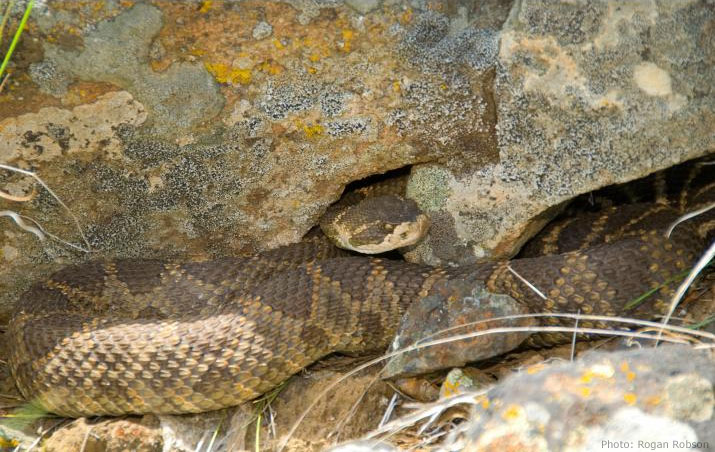
You don’t have to travel to Australia or India to bump into venomous snakes. We have three species right here in Canada! Check out our venomous reptiles below:
- The Western Rattlesnake – this is a brown, tan, grey or olive coloured snake with dark brown blotches on it’s back. It is a fairly large snake that can reach up to 1.6 metres in length. One of its distinguishing features is its triangular head. This snake has a small distribution in Canada, found in British Columbia’s Thompson Okanagan region. Habitat loss is a serious threat for this species as well as road mortality. They are listed as Threatened on the federal Species at Risk Act and are legally protected under the British Columbia Wildlife Act.
- The Prairie Rattlesnake – this snake is similar in appearance to the Western Rattlesnake. It is light brown or tan in colour with dark brown blotches on it’s back. It can also grow to be 1.6 metres in length and has a distinctive triangular head. It is found only in southwestern Saskatchewan and in southern Alberta. Threats include loss of habitat and road mortality. They are listed as Special Concern on the federal Species at Risk Act and are protected under both the Alberta Wildlife Act and the Saskatchewan Wildlife Act.
- The Eastern Massasauga – this snake grows to about 60 to 75 centimetres in length and is grey to brown in colour with dark brown butterfly or saddle-shaped blotches on its back. Its underside is black with light markings. This snake is now only found in Ontario along the eastern shore of Georgian Bay, the northern Bruce Peninsula, a small area in the Niagara Peninsula and in the Windsor area. Threats facing this species include loss of habitat and road mortality. One site even reports illegal collection for the pet trade as a threat. This species is listed on both the Federal Species at Risk Act and Ontario’s Endangered Species Act as Endangered (Carolinian population) and as Threatened (Great Lakes/St. Lawrence population).
There is another serious threat that all three of these species face and that is human persecution; even though they receive protection under numerous Acts which makes it illegal to harass, harm or kill them. Snakes have long gotten a bad rap and it’s even worse for these three species!
But these rattlesnakes aren’t out to bite you! In fact, when they feel threatened, their first response is to stay hidden or retreat to a safe spot. They will also rattle as a warning. While they will bite, this is typically done as a last resort if cornered, provoked, stepped on or handled.
If you have a snake on your property, there are some tips to avoid being bitten:
- Wear hiking boots and long pants in rocky places and areas with long grass
- Use a flashlight when out at night
- Do not reach into areas that you can’t see. Use a stick to check under rocks or shrubs first
- If you hear a rattle, stop and slowly back away from the snake
- Keep your pets on a leash
- Do not try to handle the snake
- If a rattlesnake is a direct threat to you or your family, contact your provincial wildlife department
So, while we may not all fall in love with the rattlesnakes on or near our properties, perhaps we can learn to appreciate them and learn to co-exist with them.
